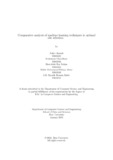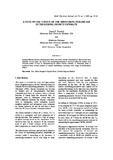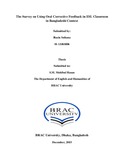| dc.contributor.advisor | Khan, Rubayat Ahmed | |
| dc.contributor.author | Aurnab, Aukik | |
| dc.contributor.author | Choudhury, Shaktiman | |
| dc.contributor.author | Ruhan, Shoubhick Roy | |
| dc.contributor.author | Rifaiya Abrar, Shikh Muhammad | |
| dc.contributor.author | Hossain Rabbi, S.M. Riyadh | |
| dc.date.accessioned | 2023-07-30T07:34:54Z | |
| dc.date.available | 2023-07-30T07:34:54Z | |
| dc.date.copyright | 2023 | |
| dc.date.issued | 2023-01 | |
| dc.identifier.other | ID: 19101485 | |
| dc.identifier.other | ID: 19101506 | |
| dc.identifier.other | ID: 19101124 | |
| dc.identifier.other | ID: 19101508 | |
| dc.identifier.other | ID: 19101511 | |
| dc.identifier.uri | http://hdl.handle.net/10361/19150 | |
| dc.description | This thesis is submitted in partial fulfillment of the requirements for the degree of Bachelor of Science in Computer Science and Engineering, 2023. | en_US |
| dc.description | Cataloged from PDF version of thesis. | |
| dc.description | Includes bibliographical references (pages 68-71). | |
| dc.description.abstract | Site selection is a crucial aspect of many businesses, as a company’s location can sig nificantly impact its success. In recent years, machine learning techniques have been
increasingly used to assist with optimal site selection by providing data-driven pre dictions about the potential success of a given location. Machine learning techniques
can be used to assist in the process of selecting the optimal site by analyzing the
patterns in data such as demographics, lifestyle services, and geographic features.
In this paper, we compare several machine learning techniques for their perfor mance in optimal site selection for features extracted from Open Street Map (OSM)
data, WorldPop population data, and Bing satellite imagery. A target dataset cor responding to the features extracted was collected from Yelp data on restaurant
check-ins, and this was used as a parameter to determine the human engagement
rate of that location with the businesses in that area. Our analysis methods in cluded SVR, Random Forest, XGBoost, Ridge Regression, Lasso Regression, and
ElasticNet. The satellite imagery collected from Bing maps were used to train CNN
architectures such as; VGG16, VGG19, ResNet, DenseNet, and InceptionV3 and the
results were compared. We evaluated the techniques using several metrics, including
Root Mean Squared Error (RMSE), Mean Squared Error (MSE), Mean Absolute
Error (MAE), Median Absolute Error(MedAE), Max Error(ME), and Median Abso lute Deviation(MAD). We used algorithm and strategies that performed the best in
related works for this research. One meta model was also implemented in this work
by an ensemble learning technique known as stacking. The model that performed
the best for the data collected was then determined by looking at the error scores of
different models. This work provides an insight into the strengths and limitations
of each technique and recommendations for practitioners considering the use of ma chine learning in site selection. This study demonstrates the potential of machine
learning for improving site selection processes and highlights the importance of con sidering multiple approaches. | en_US |
| dc.description.statementofresponsibility | Aukik Aurnab | |
| dc.description.statementofresponsibility | Shaktiman Choudhury | |
| dc.description.statementofresponsibility | Shoubhick Roy Ruhan | |
| dc.description.statementofresponsibility | Shikh Muhammad Rifaiya Abrar | |
| dc.description.statementofresponsibility | S.M. Riyadh Hossain Rabbi | |
| dc.format.extent | 71 pages | |
| dc.language.iso | en | en_US |
| dc.publisher | Brac University | en_US |
| dc.rights | Brac University theses are protected by copyright. They may be viewed from this source for any purpose, but reproduction or distribution in any format is prohibited without written permission. | |
| dc.subject | Optimal Site Selection (OSS) | en_US |
| dc.subject | Comparative analysis | en_US |
| dc.subject | Boosting and stacking | en_US |
| dc.subject | SVR | en_US |
| dc.subject | Random forest | en_US |
| dc.subject | XGBoost | en_US |
| dc.subject | Ridge regression | en_US |
| dc.subject | Lasso regression | en_US |
| dc.subject | Elasticnet | en_US |
| dc.subject | Convolutional Neural Network (CNN) | en_US |
| dc.subject | Ensemble learning | en_US |
| dc.subject | VGG16 | en_US |
| dc.subject | VGG19 | en_US |
| dc.subject | ResNet | en_US |
| dc.subject | DenseNet | en_US |
| dc.subject | InceptionV3 | en_US |
| dc.subject | Root Mean Squared Error (RMSE) | en_US |
| dc.subject | Mean Squared Error (MSE) | en_US |
| dc.subject | Mean Absolute Error (MAE) | en_US |
| dc.subject | Median Absolute Error (MedAE) | en_US |
| dc.subject | Max error (ME) | en_US |
| dc.subject | Median Absolute Deviation(MAD) | en_US |
| dc.subject.lcsh | Machine learning. | |
| dc.subject.lcsh | Artificial intelligence. | |
| dc.title | Comparative analysis of machine learning techniques in optimal site selection | en_US |
| dc.type | Thesis | en_US |
| dc.contributor.department | Department of Computer Science and Engineering, Brac University | |
| dc.description.degree | B. Computer Science and Engineering | |




